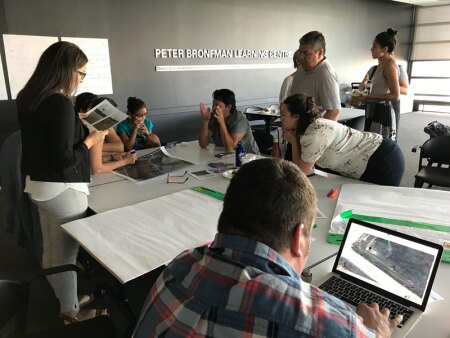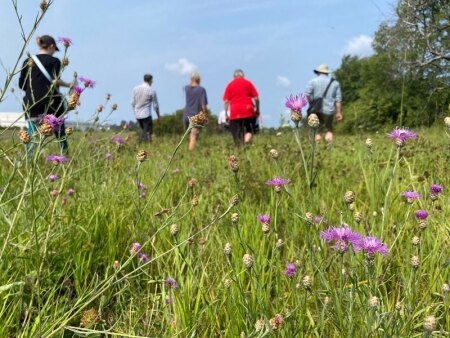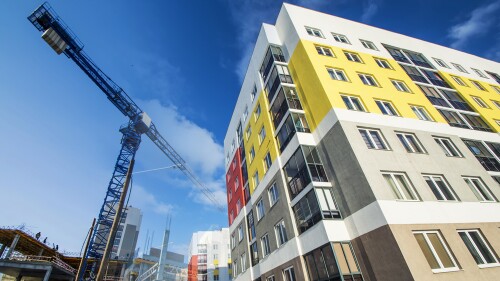Editor’s Note : This Urban Land series introduces real estate and built environment professionals to Indigenous-led organizations working on issues of environmental and climate justice in the built environment as they pertain to Indigenous communities. In addition to profiling the work of these organizations, the series covers why these intersections are critical to understand within the wider conversation on climate change and social equity. This iteration is a follow-up to a similar series of profiles created in 2020 on environmental justice, which were collected and published as ULI’s Environmental Justice and Real Estate report.
In addition to this introduction, see the organization profiles linked below:
- Indigenous Environmental and Climate Justice Series: Sustainable Native Communities Design Lab, MASS Design Group
- Indigenous Environmental and Climate Justice Series: Indigenous Climate Action
As development, natural resource extraction, and the resulting impacts of climate change continue, Indigenous peoples are often the first and most acutely affected. This comes in a variety of forms, from loss of traditional territories, biodiversity loss that negatively impacts cultural knowledge and teachings being passed down to new generations, to serious emotional and mental health decline (including high levels of poverty and houselessness).
Today, we are seeing an increasing number of instances of the damage that climate change is causing. 2023 has been Canada’s worst recorded forest fire season, with record-breaking quantities of land being scorched, and continues at time of writing in August 2023. This tragedy has displaced thousands of people and destroyed the homes of countless wildlife. The smoke from northern Ontario and Quebec spread internationally, causing New York City to experience apocalyptic skies, and having the worst global air rating that week.
Many of these challenges also impede Indigenous peoples’ ability to grow or mend a strong sense of connection and community, both with fellow humans, but also with all kin that humans rely on (animals, plants, and more). There is a serious and deep concern that youth and future generations of people will not have anything left, either to live healthy lives or learn and experience their traditional cultures. Tied to this are staggering wealth gaps and an urgent need for economic reconciliation. Too many housing, education, and economic opportunities continue to evade Indigenous communities due to systems that have grown out of a foundation that sought to snuff out anything Indigenous in the first place. It has long been past the time for this to improve.
Our firm, SpruceLab Inc., was founded in 2020 to prioritize the voices of Indigenous peoples in present-day Canada (First Nations, Métis and Inuit), because we experienced this to be a serious need in the work we do in urban planning and landscape architecture. At the heart of advancing Indigenous environmental and climate justice is a call to restructure societal systems that are perpetuating harm because of their grounding in colonial, extractive, and capitalistic paradigms. To achieve the change needed requires a collaborative, consistent, and diligent effort to decolonize the places, spaces, and systems that are still operating from such a paradigm.
To decolonize means questioning the dominant systems and structures that we work within, and asking why and how we are functioning at work, and how we relate to and interact with others. It means challenging our societal values and assumptions, and letting go of power or control to respect and acknowledge Indigenous Knowledge and worldviews in a meaningful way (as well as those of other dispossessed Peoples who have been impacted by colonization). Essentially, it is to open our minds and hearts to another worldview, despite any discomfort that might come with it, and then acting on what is learned to create decolonizing change. Respecting Indigenous sovereignty and prioritizing Indigenous voices, needs, and goals, while weaving Indigenous knowledge with that of Western/Eurocentric ways of knowing, is key to the success of this work.
Additionally, so much of what constitutes Indigenous identity and culture is centered on the land, and much of the trauma and injustice that Indigenous peoples have endured, and still endure, is deeply tied to the land. Thus, what is essential for the thriving of Indigenous peoples is the restoration of their lands, waters, and all facets of their traditional cultures. “You cannot have reconciliation and healing without a connection to the land,” as Gary Pritchard (ecologist, and member of Curve Lake First Nation) noted in A Landscape Approach, from Local Communities to Territorial Systems. These efforts require repairing relations with not just the land, but with water and all our more-than-human kin who support humanity as unique beings, also understood as being “All Our Relations”. There are positive actions where, increasingly, Indigenous voices are being raised in various spheres of society. The United Nations Declaration on the Rights of Indigenous Peoples has been a crucial step in this direction and a vital aid for governments, businesses, and organizations globally who seek to undertake such work.
Other solutions involve strategies such as Etuaptmumk, or “Two-Eyed Seeing,” a concept coined by Mi’kmaq Elder Dr. Albert Marshall, that encourages the weaving of knowledge and systems from both Western and Indigenous worldviews to see and use the best from both worlds. Essentially founded in a systems-thinking way of Indigenous Knowledge are several terms being used currently: “nature-based solutions”, a ‘triple-bottom-line’ approach (a balance of society, environment, economics), and considerations of sustainable development goals (SDGs). These concepts are now becoming central to how real estate and land use are addressing climate change, environmental degradation, and social equity.
It appears that the West is discovering what Indigenous peoples have always known when it comes to appreciating the inherent complexities and need for balance in the world we live in. Beyond borrowing these “truths,” land-based professions need to step up as leaders to raise and prioritize Indigenous voices, sciences, knowledge, and needs, and to also help address the traumas endured because of the broken relations with their lands resulting from colonization.
There are many solutions that urban development can act upon to follow the leadership of Indigenous peoples. Perhaps most foundational to this is determining the ways that colonization and harm are being perpetuated. This will take a variety of forms and will require a steady, ongoing commitment over many years. Another vital aspect of that process is recognizing internalized colonization and the many ways it affects all areas of life and work. Landscape professionals may see this appear in phrases like “plant material,” referring to plants as mere objects, or “green infrastructure,” where natural, complex systems are described and thought of as primarily mechanistic and often valued for their ability to simply save money. This could also show up in human-centric attitudes where we tend to value human needs and desires over other life forms (where nature is seen as “resources” that offer us “ecosystem services”).
Recreational countryside homes and acreages are an example, where even those seeking “nature” change the land to suit their tastes with things like manicured turf grass yards or hardscaped seawalls along coastlines. Even the concept that humans are somehow separate from nature, or are fighting against it, is a form of internalized colonization. Paired with recognition and “unlearning” will be simultaneously learning about Indigenous paradigms, ways of knowing, working, learning, and relating.
A way forward is to simply listen deeply, to truly hearing what Indigenous people are saying and sharing, which is something that cannot be stressed enough. Have open, honest conversations, and ask informed questions (take the time to learn about the culture and history of those you meet with). Do so with curiosity, respect, and integrity to build good relations and ensure that you understand what Indigenous peoples and communities are telling you. Be conscious that knowledge should not be simply solicited from Indigenous communities to help with a project, as this is also a form of extraction that continues to cause harm. There should then be a trickle-down effect on how tangible work is carried out as a result, which requires being open to new ways of working and knowing.
Through meaningful engagement we all can start to create ongoing, long-term relationships built on trust and reciprocity. Any one project has a beginning and an end, but the strong, respectful relationships created through this work can last well into the future.
Thankfully, there is a growing requirement from Canadian governments for Indigenous engagement and design and a growing need for ethical and meaningful dialogue in this space. While little guidance is offered to support this work, as the situations and Peoples vary widely, humility and common sense can prevail. Ask people how they wish to be engaged. Think about the intentions behind what you are asking and consider if it is extractive of someone’s time and insight, and who will benefit (will Indigenous peoples?).
Every request should be grounded in the principle of reciprocity, with gratitude and an offer of something in return. Honoraria provided for Indigenous engagement, for example, offered within a welcoming setting that begins with introductions to build relationships and trust that follows local cultural protocols (such as smudging with Traditional medicines, sharing food, sitting in a circle, and offering gifts of thanks). Focus on building relationships with Indigenous peoples through more than just words, pick up the phone, meet in person, and never assume anything. The settler community is often reminded that in doing any work intended for Indigenous communities: “Nothing about us, without us.”
SpruceLab has also heard repeatedly from Indigenous peoples that there is a need to go beyond land acknowledgments that list Treaty and Interest Rights Holders. In the real estate industry, this involves asking, “What does the First Nation want?”, informed by searching their websites and published interviews and letters to understand more. Real estate and land use professionals can think about their own relationships with the land and water, their personal intentions, how to decolonize their practice, and how to seek to build capacity and work in ways that benefit Indigenous communities and do not cause any additional harm.
An example of this work is the City of Kingston, in Ontario, Canada, which when encouraged by the local Indigenous Food Sovereignty Garden Group (IFSGG) and community partners to consider “shovel-worthy” projects versus “shovel-ready” ones for an expanding business park, agreed to work to work with them to help develop a definition of what this actually means. The idea of an eco-business park was proposed, and SpruceLab was engaged to lead Indigenous engagement with the community, and to support the co-creation of the landscape masterplan and supporting urban design guidelines. The IFSGG opted to collaborate with the City to create an innovative approach with the intention to shift planning and design in a way that would be more meaningful and effective at protecting their garden, community, and All of Their Relations (creatures) that live and move through it. What is currently being planned is a reimagining of these employment lands intended as a “business park” as being a community “park for business.”
Working with First Nations and local Indigenous communities to plan and design culturally appropriate affordable housing communities (Indigenous co-designed architecture), such as the work of the Sustainable Native Communities Design Lab, or park trail systems with Indigenous placekeeping elements, also exemplify decolonizing efforts and support the notion of ‘land back’ (giving land back that was taken through colonization). The Toronto Regional Conservation Authority (and the City of Toronto) is working with Williams Treaties First Nations to do this kind of work for the Morningside Park Legacy Project, in Scarborough, Ontario, Canada (alongside 4 Directions of Conservation, SpruceLab is supporting engagement and designs).
First Nations in the Vancouver area are proposing ambitious, sustainable affordable housing, for Indigenous and non-Indigenous residents. Learn more about the efforts of the Squamish Nation and the Vancouver Native Housing Society.
Additionally, real estate can look for Indigenous-owned and operated businesses to support in whatever procurement opportunities are possible. Find ways to support the improvement of First Nations lands, such as the Green Infrastructure Design Workshop for Pheasant Rump (Nakota) First Nation, led in 2019 by Sheila Boudreau of SpruceLab with the support of Urban Water Research Centre, Toronto Metropolitan University, in Toronto, Ontario, Canada. Or seek opportunities to support economic reconciliation through paid land-based training programs, such as SpruceLab’s “Earth Tending” program (with core funding from Miziwe Biik, Aboriginal Employment and Training).
In colonial countries, land-based professionals must begin to seriously consider what Indigenous peoples ask of settlers, whether those settlers recently arrived or have been here for many generations. This work also requires adhering to ethical, honest, open, and transparent practices and reflecting on the impacts of the actions that relate to Indigenous peoples, even in the procurement process. As fears about climate change are increasingly causing the questioning of societal norms, this creates an opportunity to reimagine the role of urban and real estate development and how this sector can evolve.
Many organizations are already doing this work, and two additional profiles are listed below of organizations that are Indigenous-led and Indigenous-focused, working towards climate and environmental justice. What needs to change first is the foundation that the industry itself is built on, such as recognizing the benefits of a holistic approach, and how entangled humanity is with all life forms, the waters, lands, air and sun. There is no need to give up everything that is familiar. But all professionals can add to their existing knowledge, and can weave in Indigenous worldviews and paradigms to help build a better life for all.
Indigenous Environmental and Climate Justice Series: Indigenous Climate Action
SHEILA BOUDREAU is the founder, principal landscape architect, and planner, OALA, APALA, CSLA, RPP/OPPI, MCIP, and TIFFANY ADAIR, MLA, with SpruceLab.
Additional ResourcesIn addition to the organizations profiled in this series, the following organizations are also leaders in this space:https://yellowheadinstitute.org/
https://indigenousclimatehub.ca/







